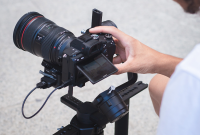The First Digital Camera
A digital camera is, in its most basic definition, a device that allows pictures to be taken. Instead than being recorded on film, the pictures are stored electronically. This procedure entails turning light into electrical charges and then transforming those charges back into the picture that was seen via the camera’s LCD. Despite the fact that the digital camera is a relatively new addition to the field of photography, the idea of the potential of a digital camera was first proposed in 1950.
It was television technology that served as the inspiration for the first digital camera idea. Beginning with the recording of digital pictures on scanners and in the form of digital video signals, the digital era started. In 1951, broadcasting firms began capturing pictures from their television cameras as electrical impulses and storing them onto magnetic tape, paving the path for the development of digital camera technology to follow. After the film industry adopted electrical impulse recording in 1956, camera makers started to fantasize about creating a similar technology for still photography.
In 1972, Texas Instruments received a patent for a digital camera that did not need the use of film. This was the first time that such a camera had been recorded in a patent. In contrast to the digital camera, the patent showed a design that was more analog in nature rather than digital, and there is no evidence that the camera was ever built. What the patent does demonstrate, however, is that there was increasing interest in digital cameras as the concept of eliminating the need for film gained traction in the industry. In the history of the digital camera, Steve Sasson, an engineer at Kodak, was a pioneering figure. NASA was transmitting digital pictures of the moon via satellite, using a mosaic photo sensor, and he recognized the potential for a digital gadget for commercial usage based on this technology. In 1972, he started to gather together existing technology used in the film business to produce images digitally rather than on film, and this eventually led to the creation of the first digital camera.
The Charged Coupled Gadget (CCD) was a key component of this early idea of the digital device, and it is still utilized by digital cameras today. The CCD detects the presence of light and the intensity of colors, and then transforms the information into electrons. The value of each cell in the picture is then read and transformed to binary format in order to make the image computer-compatible with the rest of the system. Steve Sasson created his first digital picture in 1979, when he was only 15 years old. It took a total of 23 seconds to capture the picture, and another 23 seconds for the image to be read from the playback device. Despite the fact that the picture was less than ideal, it demonstrated that the gadget was a possibility. Kodak had created a camera that produced images from light, but it was never released to the public due to financial constraints.
The Sony Mavica electronic still camera, which was introduced in 1981, was the world’s first commercially available camera. Due to the fact that the picture was captured on a small disc and then connected to a television or video, it was not a real digital camera. Although it was more of a freeze frame video camera than anything else, it had a significant impact on how people reacted to the recorded picture. A camera that could save pictures using methods other than film was made public as a result of this publication. Still using more television technology, it was the first hand-held device to be associated with the broad concept of digital camera use. Images sent through satellite were becoming more popular, but were exclusively utilized by the media because of the high cost associated with doing so. Imagery was being utilized for news coverage as the potential became more obvious to the public. The Apple Quicktake 100 camera, which debuted in 1984, was the first camera designed specifically for use with a computer. For the 1986 Summer Olympics, the Canon RC-701 was utilized to capture high-quality pictures, which were then published in the newspaper. This demonstrated the quality that could be achieved, and the desire for a digital camera was sparked.
In 1986, the world’s first mega pixel sensor was developed. It had 1.4 million pixels and was large enough to display a digital picture of 5×7 inches on a computer screen. With the introduction of the Fuji DS-P1, which was released in 1988, digital imaging accessories such as those used for storing, printing, modifying, transferring, and recording pictures hit the market in 1987. This is probably the world’s first genuine digital camera, with a 16MB memory card, as it is now recognized. The introduction of the JPEG and MPEG standards in the 1990s marked a sea shift in the appearance of the digital camera. Kodak introduced the Kodak DC40 digital camera in 1995, which was the world’s first widely accessible digital camera that fulfilled all industry requirements.



